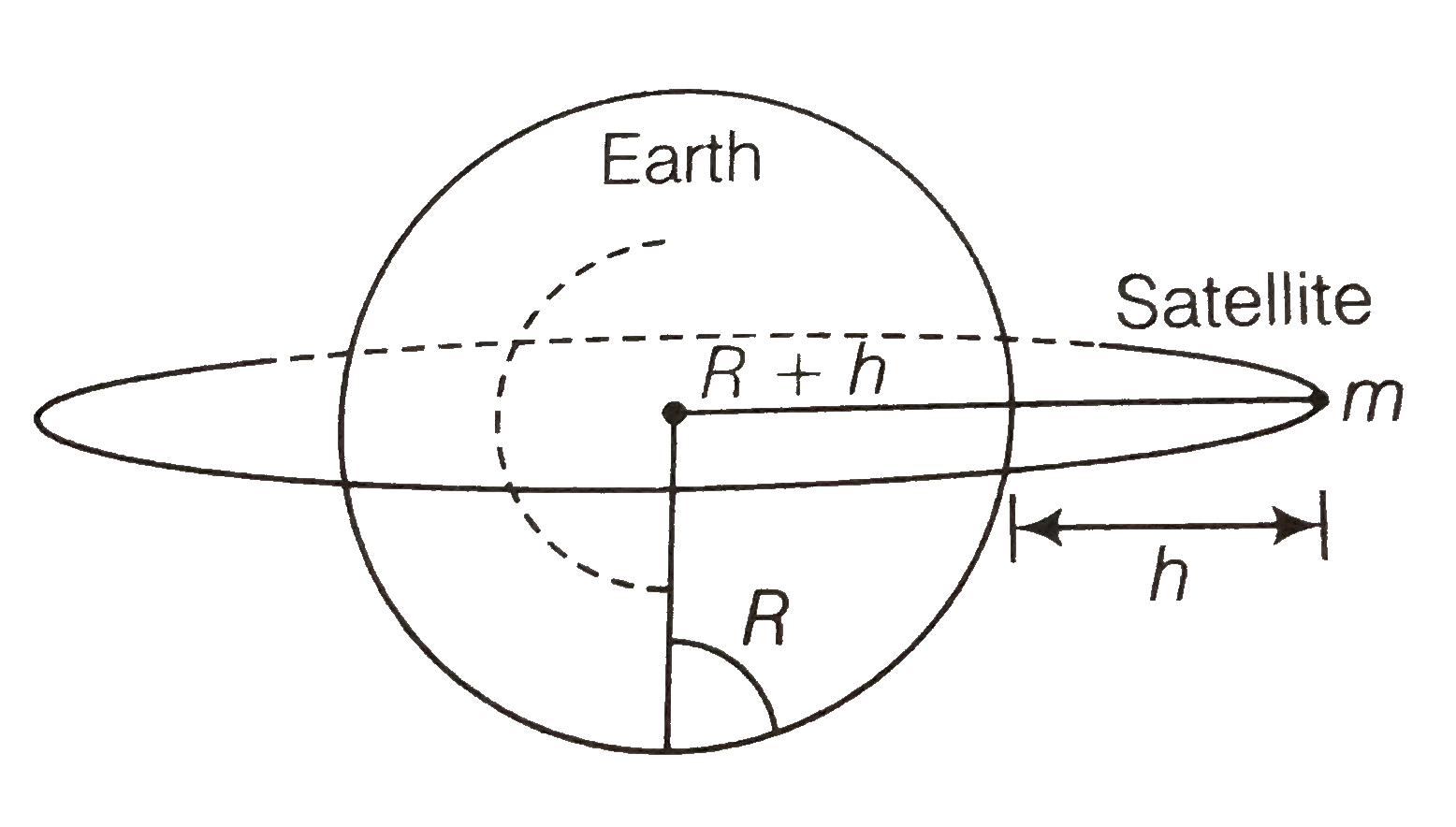A satellite is to be placed in equatorial geostationary orbit around the earth for communication.
(a) Calculate height of such a satellite.
(b) Find out the minimum number of satellites that are needed to cover entire earth, so that atleast one satellite is visible from any point on the equator.
![A satellite is to be placed in equatorial geostationary orbit around the earth for communication. (a) Calculate height of such a satellite. (b) Find out the minimum number of satellites that are needed to cover entire earth, so that atleast one satellite is visible from any point on the equator. [M = 6 xx 10^(24) kg, R = 6400 km, T = 24 h, G = 667 x 10-^(11) SI unit]](https://d10lpgp6xz60nq.cloudfront.net/physics_images/KPK_AIO_PHY_XI_P1_C08_E04_036_Q01.png)
[M=6×1024kg,R=6400km,T=24h,G=667x10−11 SI unit] Solution in Gujrati
⇒ Consider the adjacent diagram,
Given mass of the earth, M=6×1024 kg
Radius of the earth, R=6400km=6.4×106m
Time period, T = 24 h
=24×60×60=86400s
G=6.67×10−11Nm2/kg2
v0=2πrT
∴T=2πrv0
∴T=2π(R+h)√GM(R+h)
(a) T=2π√(R+h)3GM
∴T2=4π2(R+h)3GM
∴(R+h)3=T2GM4π2
∴R+h=(T2GM4π2)13
∴h=(T2GM4π2)−R
∴h=[(24×60×60)2×6.67×10−11×6×10244×(3.14)2]
−6.4×106
=4.23×107−6.4×106
=(42.3−6.4)×106
=35.9×106m
=3.59×107m
(b) 
cosθ=RR+h=1(1+hR)=1(1+3.59×1076.4×106)
=11+5.61=16.61=0.1513=cos81∘18.
θ=81∘18.
∴2θ=2×(81∘18.)=162∘36.
If n is the number of satellites needed to cover the entire earth , then
n=360∘2θ=360∘162∘36.=2.31
∴ Minimum 3 satellites are required to cover the entire earth.
Topper's Solved these Questions
- BOOK - KUMAR PRAKASHANCHAPTER - GRAVITATIONEXERCISE - Section - E Multiple Choice Questions (MCQs)73videos
GRAVITATION
- BOOK - KUMAR PRAKASHANCHAPTER - GRAVITATIONEXERCISE - Section - F Questions from Module20videos
GRAVITATION
- BOOK - KUMAR PRAKASHANCHAPTER - GRAVITATIONEXERCISE - Section - D NCERT Exemplar Solutions ( Short Answer Type Question )6videos
GRAVITATION
- BOOK - KUMAR PRAKASHANCHAPTER - LAW OF MOTIONEXERCISE - (QUESTION PAPER) SECTION-D1videos
LAW OF MOTION
Similar Questions
Which one of the following is the physical quantity of the unit Nm2(kg)2 ?
03:58View SolutionTwo particles of equal mass m move around a circle of radius R under the influence of their mutual gravitational attraction, the speed of each particle with respect to their center of mass will be ..........
01:15View SolutionMean solar day is the time interval between two successive noon when sun passes through zenith point (meridian). Sidereal day is the time interval between two successive transit of a distant star through the zenith point (meridian). By drawing appropriate diagram showing the earth's spin and orbital motion, show that mean solar day is 4 min longer than the sidereal day. In other words, distant stars would rise 4 min early every successive day. As per diagram, the earth moves from the point P to Q in one solar day.
06:15View SolutionA 70 kg man stands in contact against the inner wall of a hollow cylindrical drum of radius 3 m rotating about its vertical axis with 200 rev/min. The coefficient of friction between the wall and his clothing is 0.15. What is the minimum rotational speed of the cylinder to enable the man to remain stuck to the wall (without falling) when the floor is suddenly removed ?
01:15View SolutionAn artificial satellite of the earth is launched in circular orbit in the equatorial plane of the earth and the satellite is moving from west to east. With respect to a person on the equator, the satellite is completing one round trip in 24 h . Mass of the earth is M=6xx10^(24)kg. For this situation the orbital radius of the satellite is
04:15View SolutionAssertion: Geostationary satellite appear fixed from any point on earth.
Reason: The time period of geostationary satellite is 24 hrs03:02View SolutionA satellite is to be placed in equatorial geostationary orbit around earth for communication.
(a) Calculate height of such a satellite.
(b) Find out the minimum number of satellites that are needed to cover entire earth so that at least one satellites is visible from any point on the equator.
[M=6×1024kg,R=6400km,T=24h,G=6.67×10−11SIunits]02:14View SolutionA geostationary satellite orbits the earth at a height of nearly 36,000 km from the surface of the earth. What is the potential due to earth's gravity at the site of the satellite ? Mass of the earth= 6×1024kg and radius =6400 km.
08:19View SolutionThe time period of a geostationary satellite at a height 36000 km is 24 h a spy satellite orbits vergy close to earth surface (R=6400 km ) what will be its time period ?
01:25View SolutionFind the gravitational potential at the site of a geostationary satellites . Assume the height of the satellite to be 4200 km from the centre of Earth. (Mass of Earth =6.0xx10^(24)kg) .
08:19View SolutionCalculate the value of orbital velocity for an artifical satellite of earth orbiting at a height of 1000 km (Mass of the earth =6 xx 10^(24) kg, radius of the earth = 6400 km )
01:43View SolutionA satellite is to be placed in equatorial geostationary orbit around earth for communication.
(a) Calculate height of such a satellite.
(b) Find out the minimum number of satellites that are needed to cover entire earth so that at least one satellites is visible from any point on the equator.
[M=6×1024kg,R=6400km,T=24h,G=6.67×10−11SIunits]07:28View SolutionConsider earth satellites in circular orbits. A geostationary satellite must be at a height of about 36000 km from the earth's surface. Will any satellite moving at this height be a geostationary satellite? Will any satellite moving at this height have a time period of 24 hours?
02:14View SolutionA satellite is to be placed in equatorial geostationary orbit around the earth for communication.
(a) Calculate height of such a satellite
(b) Find out the minimum number of satellites that are needed to cover entire earth, so that atleast one satellite is visible from any point on the equator.

[M=6×1024kg,R=6400km,T=24h,G=6.67×10−11 SI unit ]06:20View SolutionAssertion : Geostationary satellites appear fixed from any point on earth.
Reason : The time period of geostationary satellite is 24 hours.03:05View Solution

